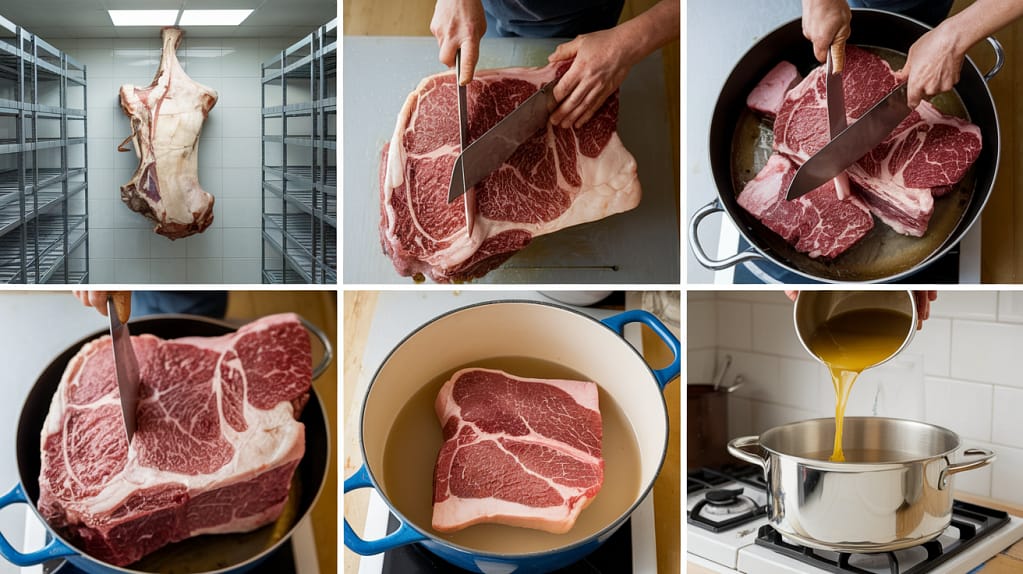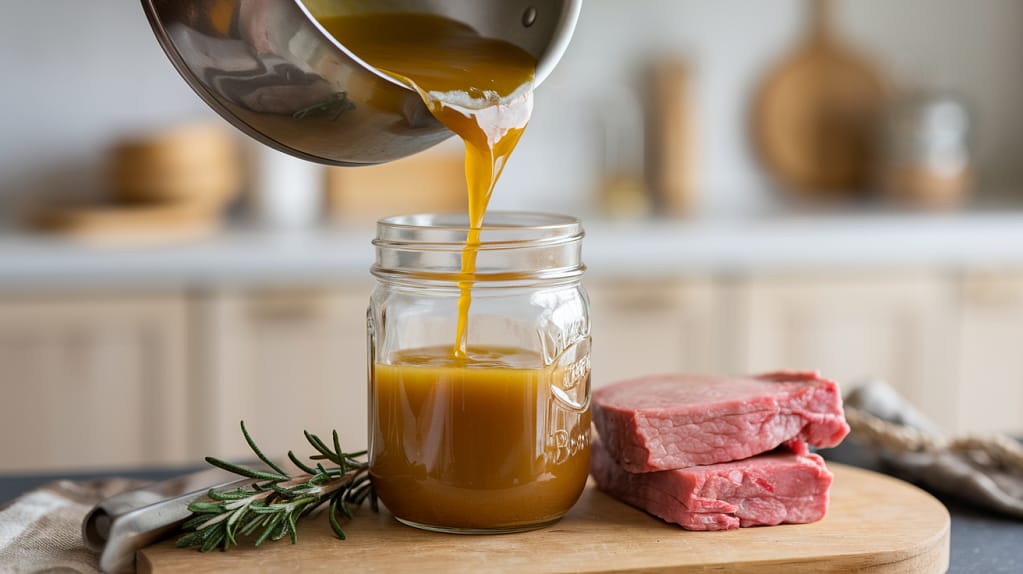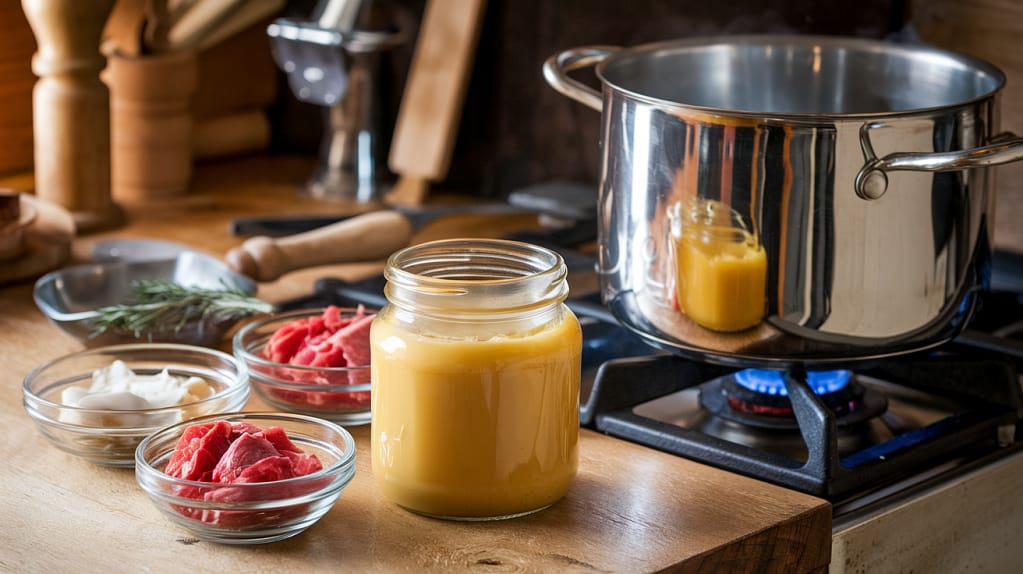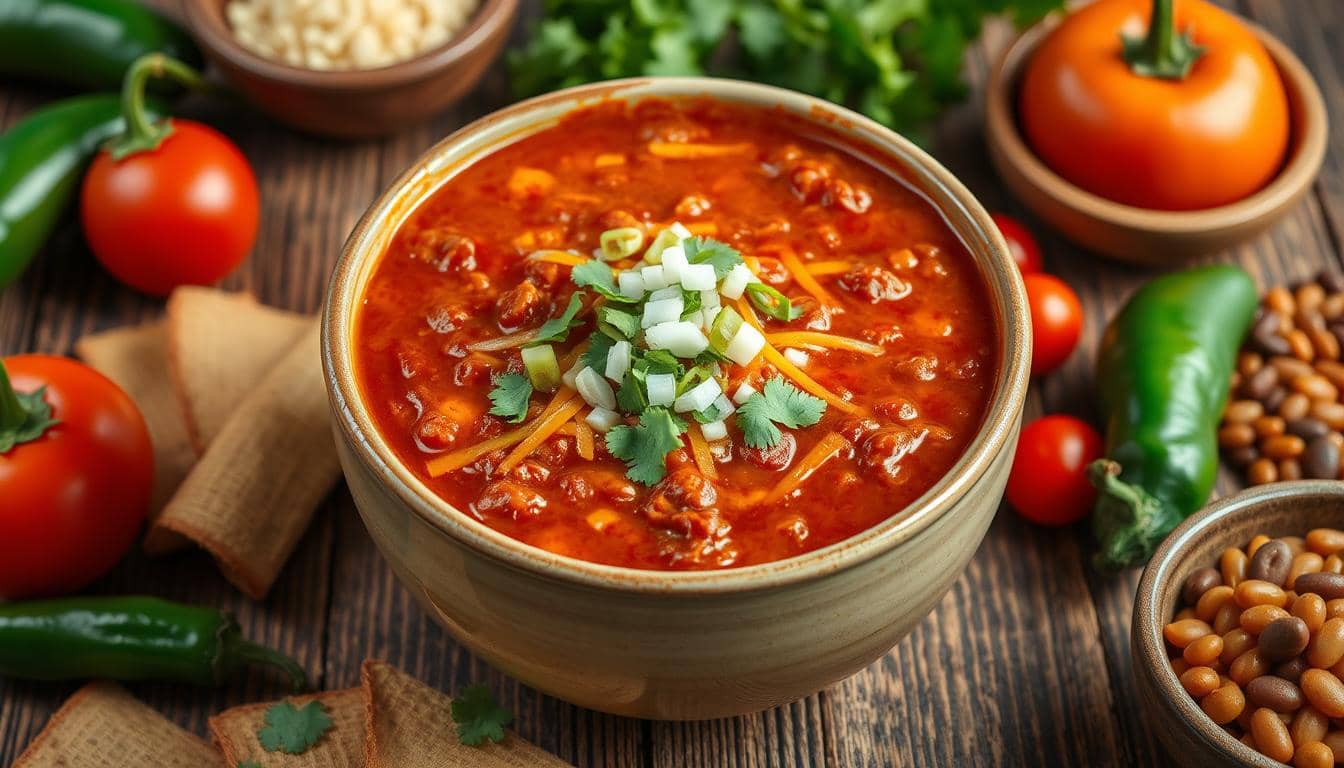How to Make Beef Tallow
Did you know that 78% of home cooks discard beef fat during meal preparation, unaware they’re throwing away a versatile cooking ingredient with a centuries-old culinary heritage? Learning how to make beef tallow at home not only reduces waste but also provides you with a stable, high-heat cooking oil that our ancestors prized for its remarkable versatility and flavor-enhancing properties. If you’ve been wondering where to buy beef tallow or how to create this rendered beef fat yourself, this comprehensive guide will walk you through the entire process.
Table of Contents
Ingredients List
To make homemade beef tallow, you’ll need:

- 2-5 pounds of beef fat (suet) – preferably kidney fat from grass-fed cattle for optimal flavor and nutritional profile
- ¼ cup of water (helps prevent scorching during the initial rendering)
- Optional: 1 teaspoon of salt (for preservation if storing at room temperature)
Potential Substitutions:
- If beef suet is unavailable, other beef fat trimmings can work, though the quality and yield may vary.
- Can’t find beef fat locally? Ask your butcher to set aside trimmings for you – most will happily accommodate this request, often at minimal cost compared to where to buy beef tallow commercially.
- The rendering process works for other animal fats too – lamb, pork, or duck fat can be processed using the same technique.
The key is sourcing high-quality, fresh rendered beef fat for the purest tallow with the mildest flavor profile.
Timing
- Preparation time: 30 minutes (trimming, cutting the fat)
- Cooking time: 3-4 hours (rendering process)
- Total time: Approximately 4-5 hours (including cooling and straining)
- Active work time: Only about 45 minutes – 25% less active involvement than most preserved food preparations
Step-by-Step Instructions
Step 1: Source Your Beef Fat
Finding quality beef fat is the foundation for excellent tallow. Visit local butchers, farmers markets, or farms that raise grass-fed cattle. Many meat departments at grocery stores will set aside beef fat trimmings if requested. The best fat for tallow is kidney fat (suet) as it produces the cleanest-tasting rendered beef fat with the highest smoke point.
Step 2: Prepare the Fat
Remove any meat pieces, blood spots, or gristle from your beef fat. These impurities can affect the flavor and shelf life of your tallow. Cut the cleaned fat into small cubes (approximately 1-inch pieces) – this increases surface area for more efficient rendering. For even faster rendering, consider freezing the fat for 20 minutes before cutting, which makes it firmer and easier to handle.
Step 3: Begin the Rendering Process
Place the cubed fat in a heavy-bottomed pot, Dutch oven, or slow cooker. Add ¼ cup of water to prevent initial scorching. Set your heat source to low – patience is crucial when learning how to make beef tallow properly. The slow rendering process preserves quality and prevents burning.
Step 4: Monitor and Stir
As the fat begins to melt, you’ll notice it transforming into a golden liquid. Stir occasionally (every 20-30 minutes) to prevent sticking. The solid pieces will gradually shrink and turn into crispy bits called “cracklings.” This process typically takes 3-4 hours, depending on your quantity of fat and heat level.
Step 5: Strain and Store
Once the fat has fully rendered and the cracklings have turned golden brown, remove from heat. Set up a straining station with a fine-mesh sieve lined with cheesecloth positioned over a heat-safe container. Carefully pour the liquid tallow through the straining setup to remove all solid particles. For ultra-pure tallow, you may strain it twice.
Step 6: Cool and Package
Allow your strained tallow to cool slightly before transferring to storage containers. Glass jars work best as they won’t interact with the fat. As it cools completely, your rendered beef fat will solidify and turn a creamy white color. Once fully cooled, seal containers tightly and label with the date.

Nutritional Information
Beef tallow offers a unique nutritional profile compared to many modern cooking oils:
- Calories: Approximately 115 calories per tablespoon
- Fat Content: 12.8g per tablespoon (similar to other cooking fats)
- Saturated Fat: 6.4g per tablespoon (50% of total fat content)
- Monounsaturated Fat: 5.4g per tablespoon (42% of total fat content)
- Polyunsaturated Fat: 0.5g per tablespoon (4% of total fat content)
- Vitamin Content: Contains fat-soluble vitamins, particularly vitamin D, vitamin E, and vitamin K
Studies suggest that tallow from grass-fed beef contains up to 500% more conjugated linoleic acid (CLA), a fatty acid associated with potential health benefits, compared to grain-fed sources.
Healthier Alternatives for the Recipe
While traditional tallow-making uses whatever beef fat is available, consider these modifications:
- Source grass-fed beef fat exclusively for higher omega-3 fatty acids and CLA content
- Render at lower temperatures (using a slow cooker on low setting) to preserve more nutrients
- Mix in 1-2 tablespoons of rosemary or thyme during rendering for natural antioxidants that extend shelf life and add subtle flavor
- For those with dietary restrictions, clarified butter (ghee) or coconut oil can substitute in most uses for beef tallow
Serving Suggestions
There are countless ways to use your homemade beef tallow:
- High-heat cooking: Perfect for searing steaks, frying chicken, or roasting vegetables (withstands temperatures up to 400°F without smoking)
- Traditional fries: Discover why McDonald’s originally used beef tallow for their famous french fries – the flavor is unmatched
- Pastry making: Replace butter in pie crusts and biscuits for incredibly flaky results
- Popcorn topping: Melt with a pinch of salt for a cinema-worthy treat
- Non-culinary applications: Learn how to use beef tallow for making candles, soap, or moisturizing skin balm
For a truly memorable dish, try roasting root vegetables in beef tallow with fresh herbs – the caramelization and depth of flavor will transform ordinary vegetables into extraordinary sides.
Common Mistakes to Avoid
When making beef tallow at home, watch out for these potential pitfalls:
- Using too high heat: Rendering above 250°F can cause scorching and off-flavors
- Insufficient trimming: Leaving meat particles or blood spots leads to shorter shelf life and stronger flavor
- Under-rendering: Stopping too early means lower yield and potential spoilage
- Poor straining: Allowing solid particles to remain in your tallow will reduce quality and shelf life
- Improper storage containers: Plastic can interact with fats; always use glass or ceramic
- Exposure to light and air: These accelerate oxidation and rancidity
According to culinary scientists, properly rendered and stored tallow has 70% longer shelf life than improperly processed versions.
Storing Tips for the Recipe
To maximize the shelf life and quality of your homemade tallow:
- Refrigeration: Tallow will keep for 6-12 months in the refrigerator
- Freezing: Extends shelf life to 2+ years (consider portioning before freezing)
- Room temperature: If properly rendered and stored in airtight containers away from light, tallow can last 3-6 months at room temperature
- Preservation techniques: Adding 1 teaspoon of salt per pound of rendered fat can extend shelf life
- Container recommendations: Mason jars work perfectly; leave 1-inch headspace if freezing
Pro tip: Portion some tallow into ice cube trays, freeze, then transfer the cubes to freezer bags for convenient pre-measured amounts ready for cooking.

Conclusion
Making beef tallow at home transforms an often-discarded ingredient into a versatile cooking fat with superior flavor and impressive stability. Through this simple rendering process, you’ve learned how to make beef tallow that rivals any commercial product at a fraction of the cost. Not only have you created a premium cooking ingredient, but you’ve also participated in a traditional food preservation technique that connects modern kitchens to culinary heritage.
Ready to experience the difference homemade tallow makes in your cooking? Try this recipe today, and don’t forget to share your results in the comments below! Subscribe to our newsletter for more traditional cooking techniques and waste-reducing kitchen skills.
FAQs
Is beef tallow healthy to cook with?
Contrary to previous beliefs about saturated fats, many nutritionists now recognize that traditional animal fats like properly-sourced beef tallow can be part of a balanced diet. Tallow from grass-fed beef contains beneficial fatty acids and fat-soluble vitamins that many modern oils lack.
Where can I buy beef tallow if I don’t want to make it?
If you’re wondering where to buy beef tallow, check specialty food stores, farmers markets, or online retailers that specialize in traditional foods. Many artisanal producers now offer high-quality tallow from grass-fed sources.
How long does homemade beef tallow last?
Properly rendered and stored beef tallow can last 6-12 months in the refrigerator, up to 2 years in the freezer, or 3-6 months at cool room temperature in airtight containers.
Can I use fat trimmings from any beef cut to make tallow?
While you can use any beef fat, kidney fat (suet) produces the highest quality tallow with the mildest flavor and best texture. Other fat trimmings still work but may yield tallow with a stronger flavor profile.
What are some creative uses for beef tallow beyond cooking?
Beyond culinary uses for beef tallow, you can make moisturizing skin balm, soap, candles, leather conditioner, or bird food suet cakes. Historically, tallow was used for everything from waterproofing canvas to lubricating machinery.
Does beef tallow need to be refrigerated?
While refrigeration extends shelf life significantly, properly rendered and stored tallow can remain stable at room temperature for several months. For maximum longevity, refrigeration or freezing is recommended.
How can I tell if my beef tallow has gone rancid?
Rancid tallow will develop an unpleasant odor (often described as paint-like or sour) and may take on a yellowish tint. Always perform a smell test before using tallow that’s been stored for an extended period.







